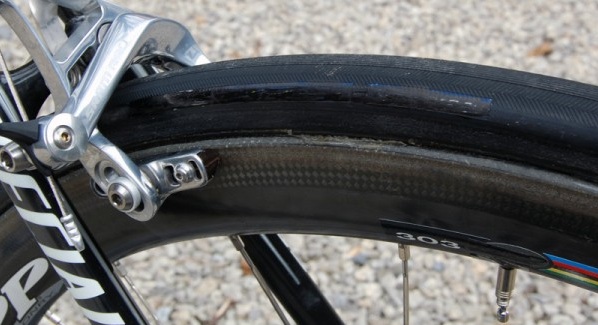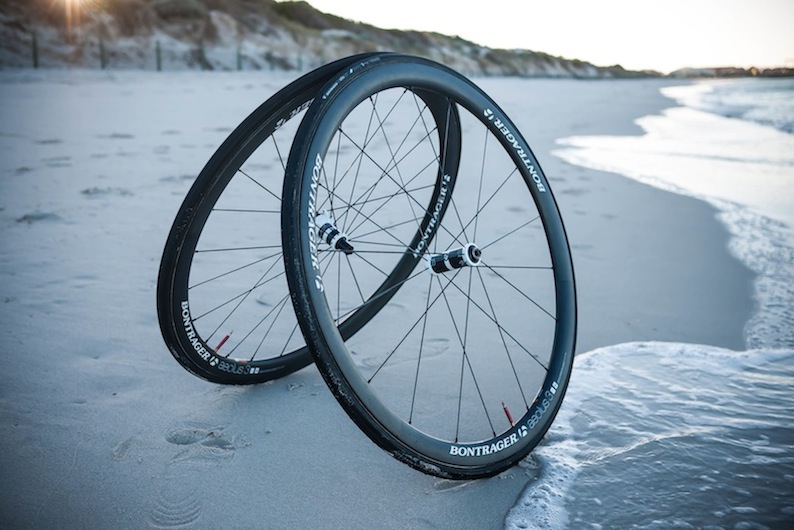
Unless you’re new to cycling I think most people know the difference between tubulars and clinchers. I don’t want to drag you into yet another yawn inducing debate trying to convince you one way or another. I think this has been point has been beaten to death. If you’re not familiar with the benefits of one or the other, I’ve cut and paste an article from velonews that pretty much sums it up:
1. Safety
When you have a sudden blow out, the tubular does not come off of the rim.2. Weight
You can hardly save any weight on the tire. But you can save quite some weight on the wheel, because the rim does not need to have (pressure proof) hooks.So all the extreme lightweight wheelsets are made for tubulars.
3. Suplesse
That is what the pro riders claim. The “feeling” would be better. There is more “life” inside the tire, meaning the rolling and cornering properties of the tires would be better.And if we are talking of real handmade tubulars (in contrast to a vulcanized tubular) the complete construction is indeed more flexible and adaptive. We cannot measure the difference with our test equipment in the lab but on the more rough surface in the real world this can be an advantage.
4. Pressure
And this argument counts only for the track. You can ride tubulars with higher pressures. This makes only sense on the very smooth surface of a track. On a road it would be no good to use pressure of more than 10 bar (140 psi).Our conclusion: Tubulars are fine if you want to ride same tire as the pros ride and if money and time do not matter for you. In the ideal case, you have a sponsor who is paying for the expensive handmade tubulars and a mechanic who is doing the nasty and time-consuming tire mounting for you.
What is more important to talk about here are the unexpected inconveniences of tubualar carbon wheels you should be aware of if you’re in the market for a set. Not that I’m against tubulars. I own a set myself. However, the first time I dropped $2500 on a tubular wheelset I was slightly taken back by some of the unexpected expenses and maintenance issues.
Brake Pads: Assuming you don’t take your nice carbon tubulars out on training rides and only save them for racing you’ll have to swap over the brake pads every time you use them. Regular brake pads are not designed for use with a carbon surface and work very poorly - especially in wet conditions. A new set of carbon brake pads will cost you anywhere from $50-$100. Also, the pads from for your training wheels will have small pieces of aluminum embedded in them and will scratch up the braking surface of your carbon wheels. I think this point is less important however it’s something that should be mentioned.
If you are going to use the same brake pads for both your carbon and aluminum wheels the pads should be carbon specific. My preference are the cork brake pads for doing this. They work well on both aluminum and carbon braking surfaces, they’re inexpensive, and they last a long time.
Truing: Most tubular wheels have the spoke nipples embedded inside the carbon shell for aerodynamics. The problem with this is that whenever you need to true the wheel you need to unglue that section of tyre to get access to the spoke nipple. This can be a pain in the ass. One of the biggest reasons I chose Zipp as my carbon wheel is because they have external spoke nipples so you don’t have to deal with this problem.
Punctures: In most cases a puncture to a tubular will mean that you’ll have to spend another $100. It’s possible to repair a puncture but in reality not to many people delve into that process (you need to unstitch the case, repair the tube as you would a regular tube using the thinnest patches you can, stitch it back up again and put a drop of crazyglue over the hole in the tread).
Also, if you get a puncture in the middle of a ride it almost certainly will require a phone call home to your wife begging her to come get you. If the tyres have been glued on properly it’ll be nearly impossible for you to get it off with your bare hands.
Changing the Tyre: The LBS will charge about $25 per tyre to glue on. Of course you can buy the glue and do it yourself for much less, but this is a time consuming and painful experience if you’re not familiar with it.
Cassette: Unless you want to change over your cassette everytime you use your tubulars you’ll have to buy a dedicated one for this wheelset. This may also entail adjusting your derailleur to suite that cassette.
There you have it. Simply dropping $2500 on your new dream tubular carbon wheels doesn’t stop there. At the end of the day it will cost you closer to $3000 as well a lot of maintenance to get you up and running. This is precisely the reason why only pros with personal mechanics or die-hard cycling aficionados ride tubulars. Is it worth it? Let me put it to you this way. Everytime I glue another set of tyres on I tell myself “never again“. BUT everytime I ride my tubulars, I’m have a big smile on my face and I’m happy I went through the hassle.














Pingback: boston carpet fitters